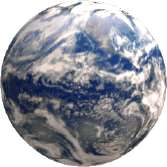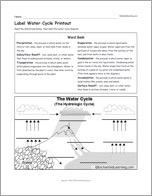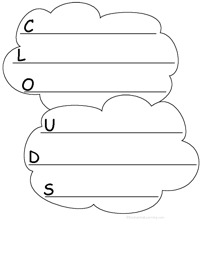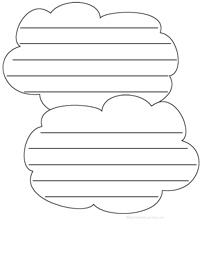Clouds
 Clouds are visible accumulations of water droplets or solid ice crystals that float in the Earth’s troposphere (the lowest part of the Earth’s atmosphere), moving with the wind. From space, clouds are visible as a white veil surrounding the planet.
Clouds are visible accumulations of water droplets or solid ice crystals that float in the Earth’s troposphere (the lowest part of the Earth’s atmosphere), moving with the wind. From space, clouds are visible as a white veil surrounding the planet.
How Clouds Form: Clouds form when water vapor (water that has evaporated from the surface of the Earth) condenses (turns into liquid water or solid ice) onto microscopic dust particles (or other tiny particles) floating in the air. This condensation (cloud formation) happens when warm and cold air meet, when warm air rises up the side of a mountain and cools as it rises, and when warm air flows over a colder area, like a cool body of water. This occurs because cool air can hold less water vapor than warm air, and excess water condenses into either liquid or ice. For more on the water cycle, click here.
Types of clouds
Prefixes and suffixes used to describe clouds
Clouds are defined by both the way they look and how high they are in the atmosphere. For example, cirro (meaning “wisp of hair”) is a prefix given to high-altitude clouds (above 20,000 feet). Alto (meaning “high”) is a prefix given to mid-altitude clouds (between 6,000 and 20,000 feet). There is no prefix for low-altitude clouds. When clouds are by the ground we call them fog.
- Nimbo
- (meaning “rain”) as a prefix, or nimbus added as a suffix, in a cloud name indicates that the cloud can produce precipitation (rain, snow, or other forms of falling water).
- Cumulo
- (meaning “heap”) refers to piled-up clouds.
- Strato
- (meaning “layer”) refers to flat, wide, layered clouds.
| Type of Cloud (Genus) |
Abbreviation | Appearance | Composition | Altitude (height) |
|---|---|---|---|---|
| Cumulo-nimbus =Thunderheads |
Sb | Can cause lightning, thunder, hail, strong rains, strong winds, and tornadoes | Near ground up to 75,000 feet (Vertical clouds) |
|
| Cirro-stratus | Cs | Thin, wispy, appears in sheets. Located above thunderheads | Above 18,000 feet (High-altitude clouds) |
|
| Cirrus | Ci | Thin, wispy, filamentous, or curly | Mostly composed of ice crystals | Above 18,000 feet (High-altitude clouds) |
| Cirro-cumulus | Cc | Small, puffy, patchy and/or with a wavelike appearance | Above 18,000 feet (High-altitude clouds) |
|
| Alto-cumulus | Ac | Medium-sized puffy, patchy, scattered clouds - often in linear bands | 6,500 - 20,000 feet (Middle-altitude clouds) |
|
| Alto-stratus | As | Thin, uniform | 6,500 - 20,000 feet (Middle-Alttude clouds) |
|
| Strato-cumulus | Sc | Broad and flat on the bottom, puffy on top. | Below 6,500 feet (Low-altitude clouds) |
|
| Cumulus | Cu | Puffy and piled up. | Below 6,500 feet (Vertical clouds) |
|
| Stratus | St | Uniform, flat, thick to thin layered clouds will ill-defined edges | Mostly composed of liquid droplets | Below 6,500 feet (Low-altitude clouds) |
| Nimbo-stratus | Ns | Uniform, dark, flat, low, featureless clouds that produce precipitation | Mostly composed of liquid droplets | Below 6,500 feet (Low-altitude clouds) |
| Fog | Very low stratus clouds | Mostly composed of liquid droplets | In contact with the gound (Ground-hugging clouds) |
Other types of clouds
- Mammatus clouds
- Dark clouds shaped like sagging pouches. These clouds often appear after a tornado.
- Orographic clouds
- Clouds that are formed as moist air rises over mountains or other major geographic features. The air floats up the side of the mountain and cools quickly, condensing and turning into a cloud.
- Pileus cloud
- A smooth cloud that is found over or on the top of a major geographic feature, like a mountain.
- Contrail
- (short for CONdensation TRAIL) is a cloud-like vapor trail that forms behind some aircraft when flying in cold, clear, humid air. The contrail forms from the water vapor contained in the jet’s engine exhaust.
Temperature on Earth
The size of the atmosphere in this illustration is greatly exaggerated in order to show the greenhouse effect. The Earth’s atmosphere is about 300 miles (480 km) thick, but most of the Earth’s atmosphere is within 10 miles (16 km) of the Earth’s surface.
The temperature on Earth ranges from between -127°F to 136°F (-88°C to 58°C; 185 K to 311 K). The coldest recorded temperature was on the continent of Antarctica (Vostok in July, 1983). The hottest recorded temperature was on the continent of Africa (Libya in September, 1922).
The atmosphere lets some infrared radiation escape into space; some is reflected back to the planet. Clouds (together with the ice caps and particles in the air) reflect about 30 percent of the solar radiation that the Earth receives. The greenhouse effect traps the remaining heat in our atmosphere.
For more information on the greenhouse effect, click here.
Atmosphere
The Earth’s atmosphere is a thin layer that surrounds the Earth. It composed of 78% nitrogen, 21% oxygen, 0.9% argon, 0.03% carbon dioxide, and trace amounts of other gases.
The atmosphere was formed by planetary degassing, a process in which gases like carbon dioxide, water vapor, sulphur dioxide and nitrogen were released from the interior of the Earth from volcanoes and other processes. Life forms on Earth have modified the composition of the atmosphere since their evolution.
For more information on the atmosphere, click here.
Label the cloud types in this printable worksheet.
Label the types of clouds in this simple worksheet!
Label the water cycle in this printable worksheet.
Write Ten Things About Clouds - A short answer printable worksheet. Write ten things about clouds (plus one thing you would like to change).
Clouds Acrostic Poem - Write a poem about clouds. Start each line with a letter from the word ‘cloud.’
Clouds: Shape Poem - Printable Worksheet. Write a poem about clouds inside the picture.
Adjectives Describing A Clouds - Printable Worksheet. Write adjectives describing the clouds in and around the clouds. An adjective is a word that describes, identifies, modifies, or quantifies something (a noun or a pronoun). In the phrase, the black cat, the word black is an adjective because it describes the cat.
Clouds: Fact or Opinion? Blank, A Worksheet. Color the clouds and write 5 facts and 5 opinions about clouds. A fact is something that is true and is supported by evidence. An opinion is something you believe or feel to be true and is open to debate.




